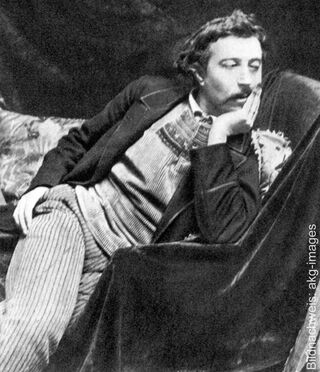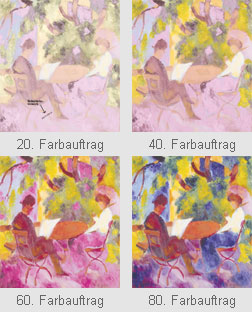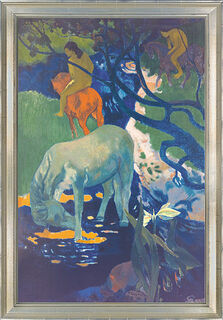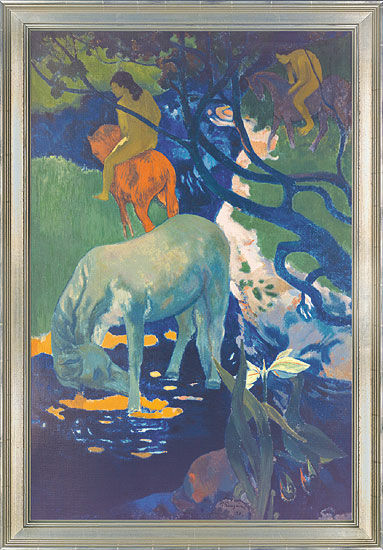Picture "The White Horse" (1898), framed


Picture "The White Horse" (1898), framed
Quick info
limited, 950 copies | original Dietz replica | oil on canvas | on stretcher frame | framed | size approx. 92.5 x 64.5 cm (h/w)
Detailed description
Picture "The White Horse" (1898), framed
A pharmacist commissioned Gauguin to paint a painting of a white horse. When he finished the panting, the pharmacist rejected it, saying: "I wanted a painting with a white horse. This horse is green." In art history, the title of the painting is still "The White Horse" (Le cheval blanc), and it is considered the most decorative painting by Gauguin.
Original: 1898, oil on canvas, 140 x 91.5 cm, Musée d'Orsay, Paris.
Original Dietz replica. Oil on canvas in 104 colours. Limited edition of 950 copies. Each canvas replica is stretched on a stretcher frame according to the original, so you can re-stretch the canvas as room temperature and humidity fluctuate. Framed in a silver real wood frame. Size incl. frame approx. 92.5 x 64.5 cm (h/w).

About Paul Gauguin
1848-1903
Paul Gauguin was a french painter, sculptor, ceramicist and graphic artist. He made a fundamental contribution to 20th-century art by developing form and colour as expressive values.
It was not until 1872 that the Parisian stockbroker Paul Gauguin, who was born here on 7 June 1848, discovered his interest in painting through his friend Claude-Emile Schuffenecker. Gauguin began to collect the works of the Impressionists and studied painting at the Académie Colarossi in Paris. He met the Impressionists Pissarro and Cézanne, worked and exhibited with them. In the artist's colony of Pont-Aven, he met Bernard and in Paris Degas and the van Gogh brothers.
In 1890 Gauguin decided to emigrate, sold his paintings and set sail for Tahiti on 1 April 1891. However, illness and impoverishment forced him to return to Paris in 1893.
In 1895, he said goodbye to his five children and his danish wife, whom he had already married in 1873, and left Paris for good. The following eight years in the South Pacific were again marked by illness and money worries, which weighed so heavily on him that he wanted to return to Paris. But his patrons in France advised him to not return, for not wanting to destroy the myth of the South Pacific painter.
The pictures he regularly sent to his art dealer Vollard show an exotic world of foreign culture and seemingly happy, unselfconscious people: the thought-to-be-lost paradise. His late work, painted in Tahiti, is full of colour intensity, harmony and beauty, and gives no hint of Gauguin's painful years until his death on 8 May 1903 in Atuona Hiva-Oa on the Marquesas island of Dominique.
Günter Dietz developed a revolutionary method for the authentic reproduction of paintings, where not the usual printing inks are used, but the same original colours used by the artist. Depending on the artist's painting technique, up to 140 (!), different paint applications need to be applied in order to achieve a perfect replica of the original that also tangibly reproduces the "relief" and pastosity of colour composition.
Here are the examples of 'Couple at the Garden Table' by August Macke:

Furthermore, the same material as the original, such as reproduction on canvas, paper, wood, copper, parchment is always used.
The result is a perfect, gridless reproduction that comes very close to the original in expressiveness and effect. Even museum specialists often can not distinguish the replica from the original. Therefore, a special security note must be added, which is visible only under X-rays.
The edition of most Dietz replicas is limited, usually to 950 copies. Each canvas replica is stretched onto a frame as the original, so you can retighten the canvas in case of fluctuations in room temperature and humidity. A high-quality solid wood strips round off every Dietz replica.
Numerous masterpiece paintings of Rembrandt, Caspar David Friedrich, Claude Monet, Gustav Klimt and various others have been recreated by the "Dietz Offizin". Famous modern artists such as Pablo Picasso, Salvador Dalí, Max Ernst, Friedensreich Hundertwasser, Joan Miró and Marc Chagall have used this method developed by Günter Dietz in order to have replicas of their works produced.
Press comments:
"The Dietz System provides images as good as the originals. What the electronics did with the invention of Hi-Fi and stereo for music playback - here the graphic technology made up for visual art." (Die Zeit, German newspaper)
"In theory, there is no difference between the original and the Dietz replica. They should not be called reproductions, but facsimiles." (Newsweek, US-American news magazine)
"For art printers all over the world remains unrealizable to this day, what Dietz only managed with the help of printing technology: The perfect reproduction of painted works." (Der Spiegel, German news magazine)
The style of Impressionism, which emerged in French painting around 1870, owes its name to Claude Monet's landscape 'Impression, Soleil Levant'. After initial rejection, it began a veritable triumphal procession.
Painters such as Claude Monet, Edgar Degas, Edouard Manet, Auguste Renoir and others created motifs from everyday life, urban and landscape scenes in bright, natural light.
Impressionism can be seen as a reaction to academic painting. The emphasis was not on content with its strict rules of painting structure, but on the object as it appears at any given moment, in an often random cut out. The reality was seen in all its variety of colours in natural lighting. The Studio painting was replaced by open-air painting.
Through the brightening of the palette and the dissolution of firm contours, a new approach to colour emerged. In many cases, the colours were no longer mixed on the palette but side by side on the canvas so that the final impression lies in the eye of the viewer with a certain distance. In "Pointillism", (with painters such as Georges Seurat or Paul Signac) this principle was taken to the extreme.
Outside France, Impressionism was taken up by painters such as Max Slevogt, Max Liebermann and Lovis Corinth in Germany, and by James A. M. Whistler in the United States.
However, Impressionism was only expressed to a limited extent in the art of sculpture. In the works of Auguste Rodin, who is considered one of the main representatives, a dissolution of surfaces is evident, in which the play of light and shadow is included in the artistic expression. Degas and Renoir created sculptures as well.
A true-to-the-original reproduction of an artwork in the same size and with the best possible material and colour uniformity.
The mould is usually taken directly from the original so that the replication reproduces even the finest details. After casting the replication, using the most appropriate method, the surface is polished, patinated, gilded or painted according to the original.
A replication of ars mundi is a recognizable copy of the original.


